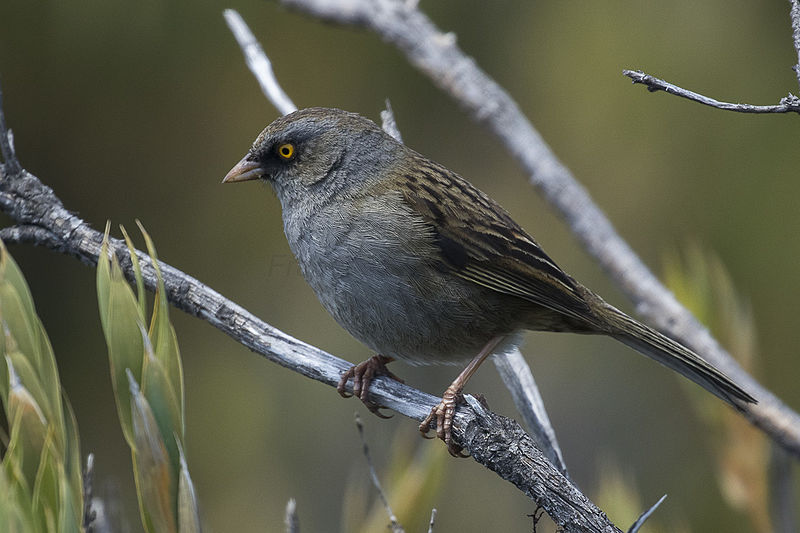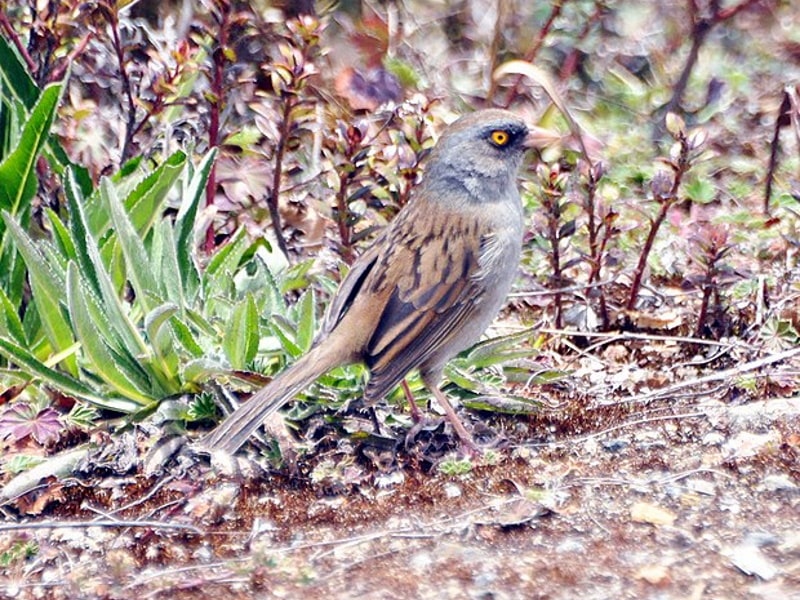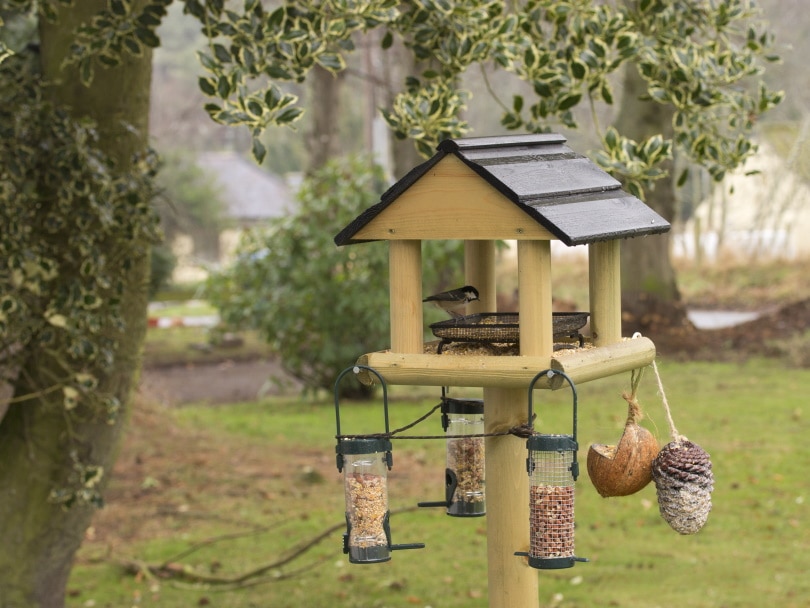Volcano Junco: Field Guide, Pictures, Habitat & Info
Last Updated on

Popular as the New World sparrow, the Volcano Junco is the resident bird of Costa Rica’s Talamancan montane forests and Western Panama. Because of their striking yellow eyes and full-black complexion, these birds have a demonic appearance.
Some Volcano Juncos are gray with brown backs, browner flanks, and black streaks. They also have pale pink bills found in open woodlands and habitats. They usually live at high elevations, mainly above 3,000 meters and down to 2,500 meters.
You’re likely to spot Volcano Juncos in small shrubs and on the ground. They are primarily seen in pairs or small groups. Let’s learn more about their range, nesting, habitats, and behavior.

Quick Facts About the Volcano Junco
| Habitat | Open woodlands |
| Diet | Seeds, insects, and berries |
| Behavior | Ground forager |
| Nesting | Ground |
| Conservation | Low concern |
| Scientific name | Junco vulcani |
| Lifespan | 3–11 years |
Volcano Junco: General Description

A Volcano Junco looks like a Yellow-eyed Junco but is much larger than the latter. They have a black head, brown upper parts, and dark streaks on the back. Their distinctive brownish-black plumage details make them stand out among other junco species.
Many people confuse Volcano Juncos with Yellow-eyed Juncos because of their yellow eyes. But Volcano Juncos are darker and grayer than their yellow-eyed siblings. You can identify the juveniles through their buff-gray underparts and light brown backs with black streaks.
These birds are typically terrestrial and stay limited to Costa Rica and Panama only. Therefore, to spot Volcano Junco, you must travel to these countries.
Volcano Junco: Range, Habitat, Behavior, Diet & Nesting
Besides their intimidating appearance, Volcano Juncos have so much more for birdwatchers to know about. Their diet, nesting, and habitat are similar to other junco species. Here is an easy breakdown of all these aspects:
Range
Volcano Juncos are limited to specific mountains of Western Panama and Costa Rica. They are mostly terrestrial and non-migrant birds. These birds prefer staying above the timberline at altitudes of more than 10,000 feet or 3,000 meters.
Volcano Juncos in the Caribbean areas of Costa Rica stay at an elevation of around 7,000 feet or 2,100 meters.
Habitat
Volcano Juncos inhabit open bushy and grassy areas, preferably with short-heightened scrubs. Some subspecies may live in ponderosa pine, mixed coniferous, and pine-oak forests like Yellow-eyed Juncos.
Volcano Juncos may move to lower elevations on colder days to scrub pastures, oak woodlands, and fields. You’re likely to see them running or jumping on the ground and taking short distances.
Behavior
Volcano Juncos are ground foragers, so they mostly stay in small shrubs on the ground. In the winter, these birds travel to lower elevations, forming pairs or groups of up to 40 birds. But these birds rarely move and stay in the same nesting area all year.
Volcano Juncos are naturally non-aggressive birds, but they may sometimes become aggressive. For example, some may call or twitter at other birds, show aggressive displays, or chase till they leave their territories.
Some male Volcano Juncos may sing and show aggression during the breeding season. These birds stay in pairs for a significant time and may find new partners afterward.

Diet
The diet of Volcano Junco consists of seeds, insects, spiders, and berries primarily present on the ground. They rarely hunt but may search for small insects to capture and eat them. Almost all junco species, including yellow-eyed and dark-eyed ones, love to feast on sunflower seeds.
Nesting
Considering their ground foraging behavior, Volcano Juncos build their nests on the ground. The female picks a spot under a rock, bush, or log or in a tree cavity present in a vegetated area. The base of the nest is typically on a grass clump in a shady place.
When building a nest, the female Volcano Junco makes a hollow shape on the ground with their feet and bill. Then, they gather pine needles, grasses, and moss and weave them to build a bulky, neat cup-shaped nest. The nest is then lined with fine hair and grasses.
The female usually lays two pale blue eggs with brown spots.
How to Find Volcano Junco: Birdwatching Tips
Volcano Juncos fly at both high and low elevations. So, spotting them can be very easy if you know what to look and listen for and the right time to do that. These demonic-like birds are unique, and you surely won’t want to miss them on your trip to Costa Rica or Panama.
Here are a few birdwatching tips to help you spot Volcano Juncos quickly:

What to Listen For
Male Volcano Juncos usually sing during the breeding season, particularly when mating. Their song sounds like “k’chew chu k’wee chip chip chueee,” which is a mixture of buzzes and squeaks.
These birds also give thin “tseee” or clear “wheew” calls. If you have good ears, close your eyes, carefully listen to the bird’s song, and call to know they are nearby.
What to Look For
Keeping Volcano Junco separate from other junco species is very tricky. You must remember all their identification signs, such as length, weight, color, and behavior. Here are a few things to look for when finding Volcano Juncos in open woodlands:
- Size & Shape. The average length of a Volcano Junco is around 6.3 inches. Their average weight is about 0.9 ounces or 28 grams, making them heavier and larger than Yellow-eyed Volcano Juncos.
- Volcano Juncos have buff-gray underbodies, light brown upper bodies with black streaks, and tails and wings with dark edges. Their eyes are yellow, and their legs and beaks are flesh-colored. Females, males, and juveniles may differ in color, so make sure you know everything properly.
- These birds are non-aggressive, terrestrial, and non-migratory birds. They stay on the ground, nest, breed, and forage throughout their lifetime. You may also find Volcano Juncos taking smaller flights or hopping.
When to Look
Volcano Juncos are resident in Costa Rica and Panama all year. So, you can look for these birds any time of the year you want.
Attracting Volcano Junco to Your Backyard: Tips & Tricks
Inviting Volcano Juncos to your yard is quite simple since these birds are ground foragers. If you live within these birds’ range, you can attract them to your backyard any time of the year with a few tricks. Here are a few:
- Install bird feeders filled with the bird’s favorite foods, such as sunflower seeds. Platform feeders work best for Volcano Juncos since they are ground foragers. You can also opt for berries and small insects to lure these birds in.
- Place a bird bath to help the birds unwind and cool off during hot weather.
- Volcano Juncos nest on grass clumps, so make sure your backyard has significant grass or stunted scrubs on the ground.
- Most bird species come to areas that look welcoming and well-maintained. Thus, ensure the cleanliness of your yard and make it look spacious for Volcano Juncos to come and live.

Volcano Junco Conservation: Is This Bird Threatened?
Volcano Juncos are common birds in Costa Rica and Panama, but there has been no standard population assessment. Partners in Flight gives them a 5 score for their global population size. They are also “red” on the Partners in Flight Watchlist, making them highly vulnerable in the upcoming years.
Volcano Junco populations need proper conservation care to maintain their numbers in the future.

Final Thoughts
Volcano Juncos are blackbirds with a demon-like appearance. They are Costa Rica and Panama residents, living there throughout their life. They don’t migrate and find their mates in the nearby territories. This means you can spot these birds anytime you want.
Remember that Volcano Juncos are larger than Yellow-eyed Juncos. These birds have buff-grayish underparts and brown upper bodies with black streaks. They also have a distinctive song and call.
Featured Image Credit: Volcano Junco (Image Credit: Francesco Veronesi, Wikimedia Commons CC BY-SA 2.0)
Table of Contents
About the Author Jeff Weishaupt
Jeff is a tech professional by day, writer, and amateur photographer by night. He's had the privilege of leading software teams for startups to the Fortune 100 over the past two decades. He currently works in the data privacy space. Jeff's amateur photography interests started in 2008 when he got his first DSLR camera, the Canon Rebel. Since then, he's taken tens of thousands of photos. His favorite handheld camera these days is his Google Pixel 6 XL. He loves taking photos of nature and his kids. In 2016, he bought his first drone, the Mavic Pro. Taking photos from the air is an amazing perspective, and he loves to take his drone while traveling.
Related Articles:
10 Types of Hummingbirds in Arkansas (With Pictures)
8 Types of Hummingbirds in Nebraska (With Pictures)
5 Types of Hummingbirds in Idaho (With Pictures)
3 Types of Hummingbirds in Mississippi (With Pictures)
8 Types of Hummingbirds in Kansas (With Pictures)
5 Types of Hummingbirds in West Virginia (With Pictures)
5 Types of Hummingbirds in Ohio (With Pictures)
Where Do Nuthatches Nest? Nuthatch Nesting Habits Explained
